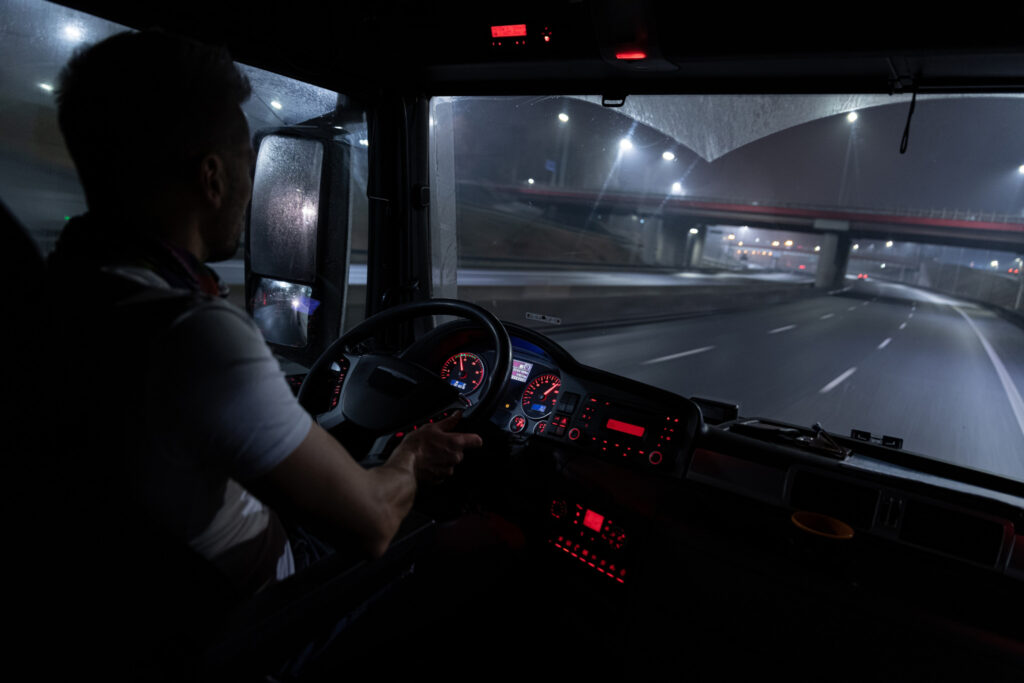Caution, awareness keep trucks rolling safely in the dark
It’s time to embrace driving in darkness as clocks are reversing an hour this weekend across most parts of the country.
The trucking industry does not have days off and those working this Sunday may want to get into bed earlier on Saturday, as daylight saving time ends at 2 a.m. on Sunday, Nov. 4.
That’s what Philip Fletcher, president of the Truck Training Schools Association of Ontario, used to do when he worked as a longhaul driver. “You may want to recoup that sleep before you go on the road again,” he said.

For the next few months truckers must deal with fewer hours of daylight and more of what Mother Nature throws at them, including fog, rain, ice, snow, and wind.
Many drivers start their day early in the morning and end it late, which means additional hours of driving in the dark during fall and winter.
Fletcher says driving in the dark has its advantages, because lights help drivers maintain a safe following distance and maintain awareness of surrounding vehicles.
But headlights from oncoming vehicles, especially on narrower regional and interior roadways, can be distracting and dangerous.
When a vehicle approaches, look to the right of the road and not the middle, advises Fletcher. “Guide your driving based on the line on the right of the road, not the line in the middle, directing your gaze away from the headlights,” he says.
Anti-glare glasses
Red Deer, Alta.-based longhaul drivers Marylynn Downham and Brian Keyes use yellow anti-glare glasses when driving in the dark. “It makes my vision a bit more crisp and works well in rain and fog. I count on those glasses a lot,” says Downham.
Keyes uses prescription glasses with an anti-glare coating. “You can get clip-ons too,” Downham adds.
Downham says she takes multivitamins to ensure the wellbeing of her eyesight. As drivers get older, night vision – the ability to see well in low-light-conditions – deteriorates. A 50-year-old driver may need twice as much light to see as well as a 30-year-old, according to the American Optometric Association.
As darkness sets in early and you are not used to it, fatigue can also creep in. Pull over and take a break, advises Fletcher.
“If you need to pull over, do so. There is no shame in pulling over and taking a rest or nap to get rid of the fatigue,” he says.

Fresh air to keep alert
He always kept a window open on the passenger side to keep fresh air flowing into the cabin. He also chose talk shows on the radio which helped maintain awareness rather than listening to music that caused him to relax.
Downham and Keyes also say a nap re-energizes them if they are fatigued and drowsy.
And when bad weather rolls in at night, drivers must adjust speed to conditions. Fletcher has a simple formula. When the road is wet, take off about a third of your speed. When it is snowing and you see your mirrors freezing up, drop to half the posted speed limit. And when you see the glare of ice on the roadway, go down to a third of the limit, as stopping time increases.

Shabnam, a longhaul driver who works in a team with husband Palwinder Singh hauling loads from Ontario to California and back, says if there is freezing rain, she stops every half hour to check the road. “I reduce my speed, don’t use the engine brake and use the foot brake when needed, gently,” she says.
Watch out for frost
Keyes says when driving around shaded corners you have to watch out for frost, and it is important to respect the road. Shady areas get a lot icier during the night. The spray from your tires is a good indicator whether the road is icy or not, he adds.
It is also key to pay attention to temperatures and make sure tires are properly inflated, adds Downham. “Slow down, no load is worth your life.”
Keyes says while driving up and down mountains at night, there are lots of corners and one must be aware that danger could lurk around the next bend.
Wildlife on the road
That danger could come in the form of animals along roadways, especially during fall and spring. Fletcher says from personal experience that if you see one deer crossing the road, expect to see more as they move in herds. If possible, try to avoid areas where moose are present because colliding with them could prove fatal for the driver.
Shabnam says roadkill is a problem on highways at night and she keeps her eyes peeled for larger carcasses that could flip her truck over.
Sadly, there are also motorists who get behind the wheel impaired by drugs and alcohol and truckers must steer clear of them. Downham and Keyes have seen plenty of them at night and have reported them to law enforcement. It is best to keep a healthy distance from them as they may swerve all over the roadway. If a safe opportunity arises, drive past them, the drivers say.
Shabnam remembers seeing a wrong-way driver on a U.S. highway, driving toward her rig at night last year. She called the police, but the motorist collided with another car and both drivers died in the crash, she recalls.
Despite the added challenges of driving in the dark, caution and a healthy dose of awareness can help keep the wheels rolling and drivers safe as they head to their destinations.
Have your say
This is a moderated forum. Comments will no longer be published unless they are accompanied by a first and last name and a verifiable email address. (Today's Trucking will not publish or share the email address.) Profane language and content deemed to be libelous, racist, or threatening in nature will not be published under any circumstances.
Start by removing after market road lamps aimed at the sky as well as poorly aimed headlights.
And, please stop flashing high beams for passing trucks – you’re just blinding someone looking in the mirror.
Use your marker interrupt switch or, some trucks the signal stalk moves forward to turn off headlights for a second.
Besides if you need a flash to change lanes – you’re either a poor driver or too damn close.
Very good all information
DST sucks

Like I have seen on Highway 17 going east in Ontario this sign is not very big but it has this: “Say the three D ” goes for Daze, Dose, Dead.
I always will remember these three D’s.
Not to forget. especially at night or in the dark.